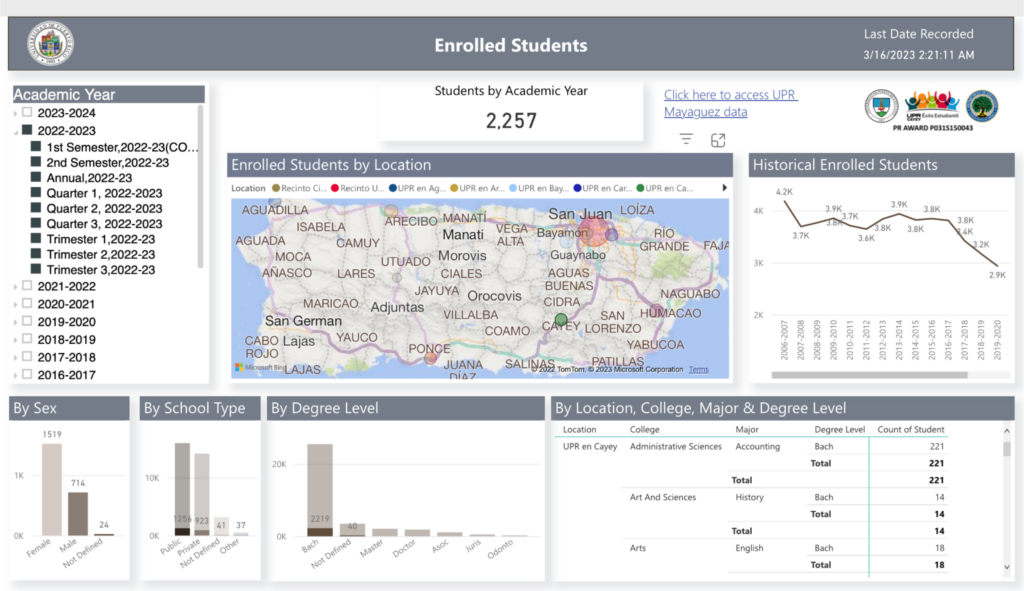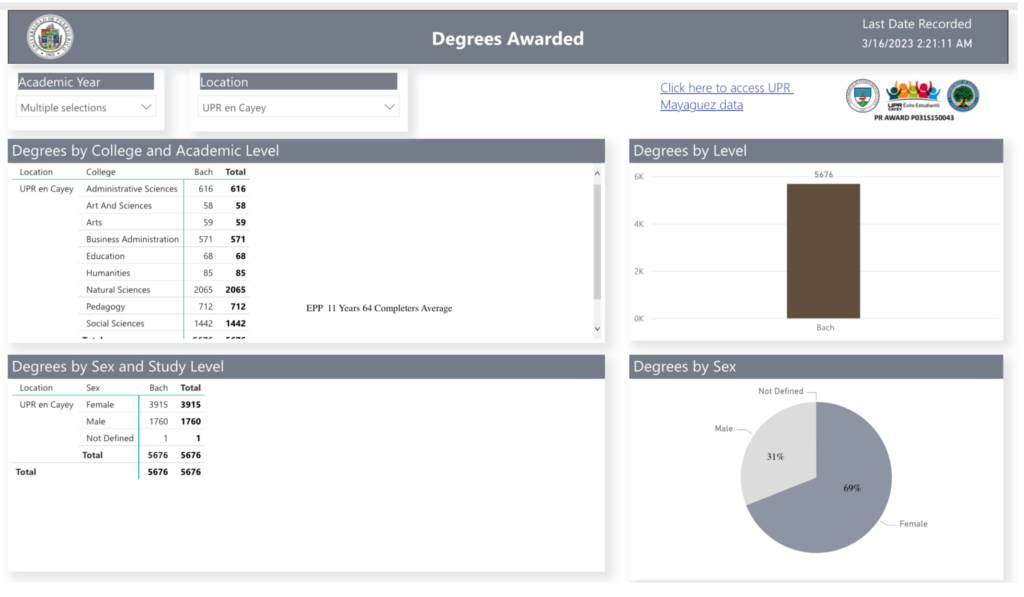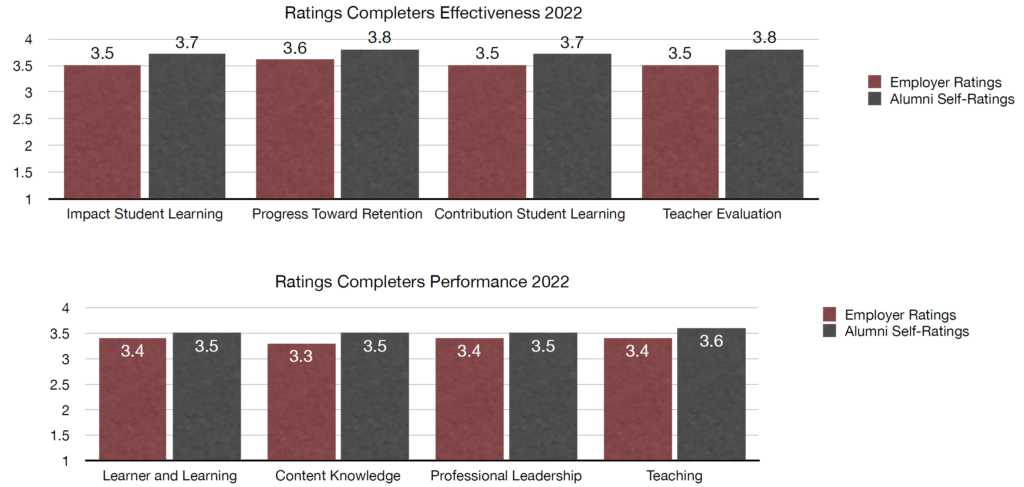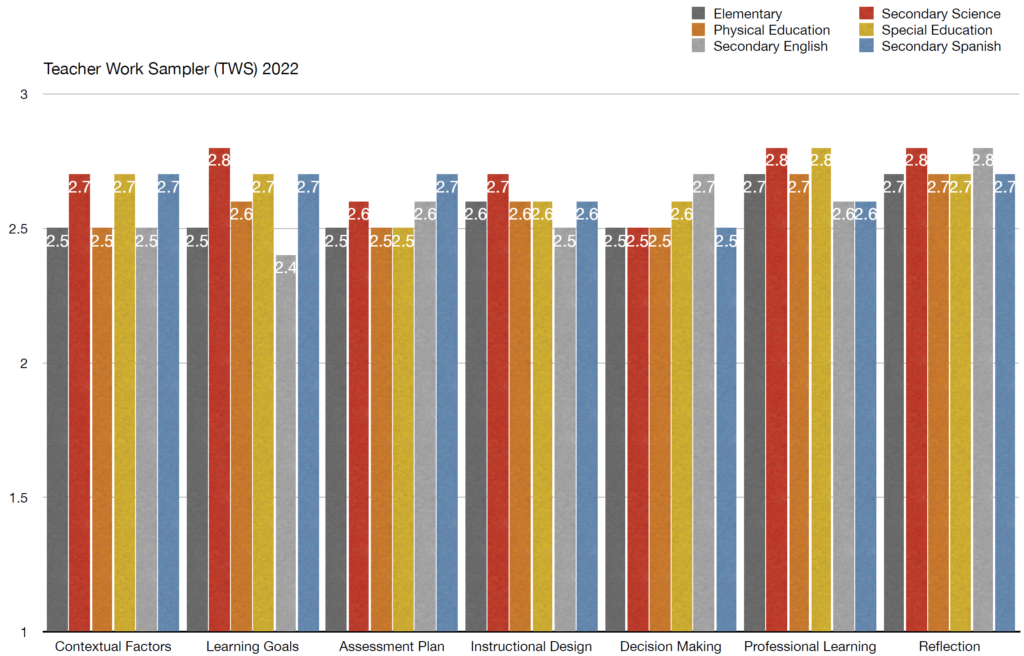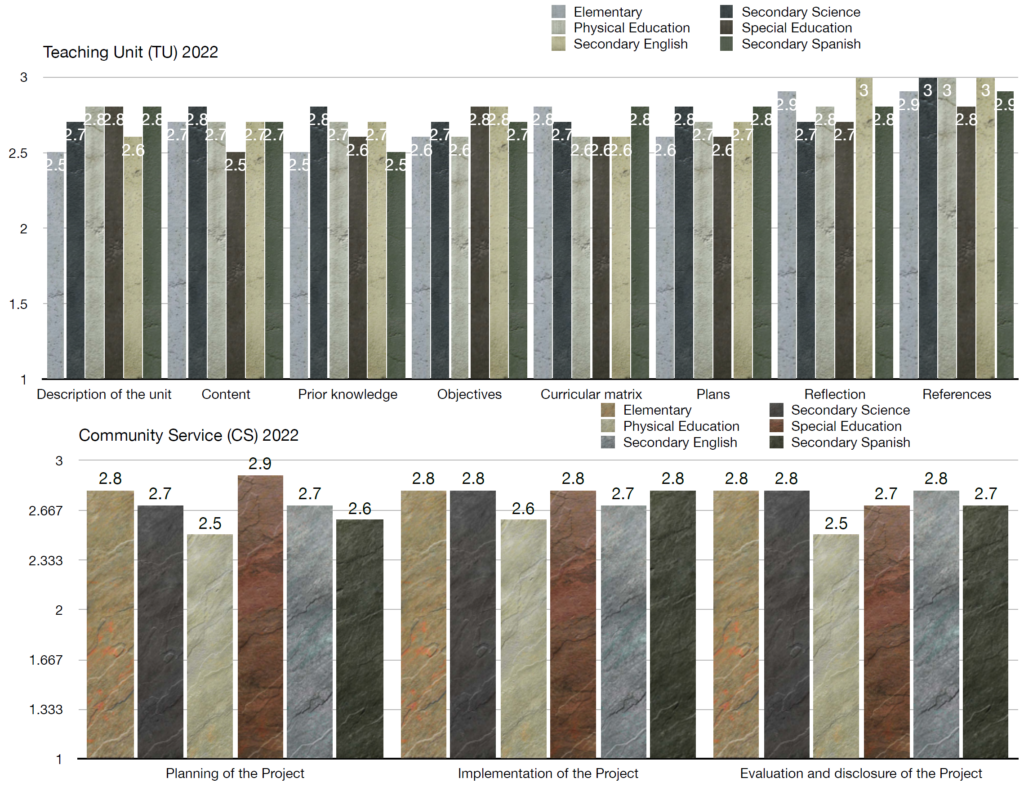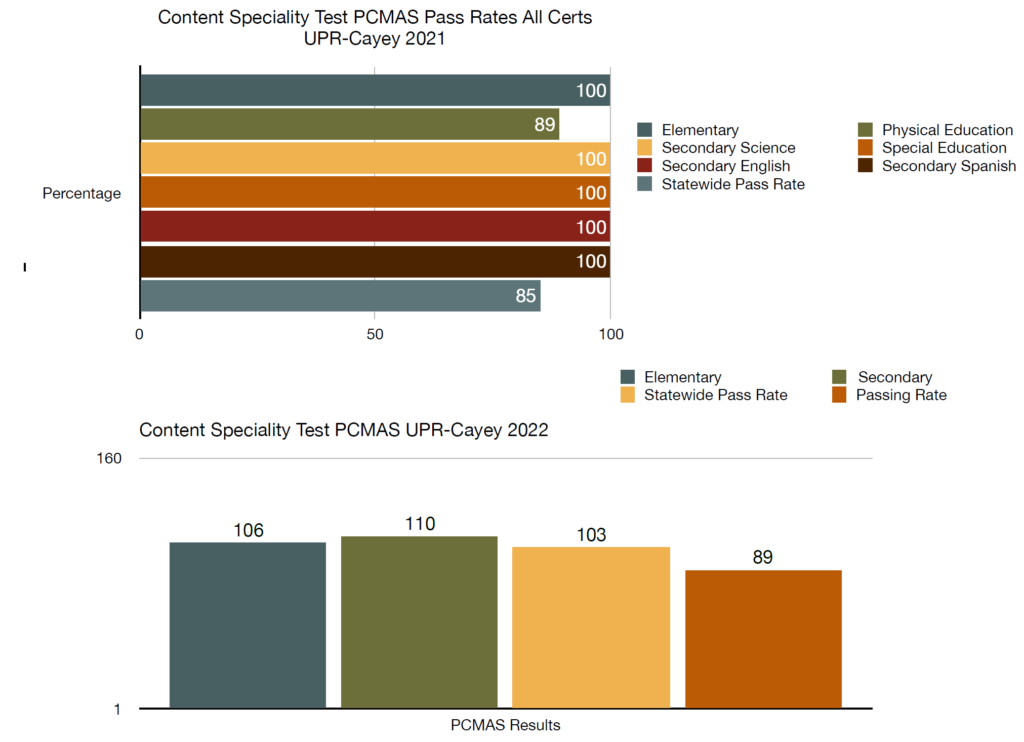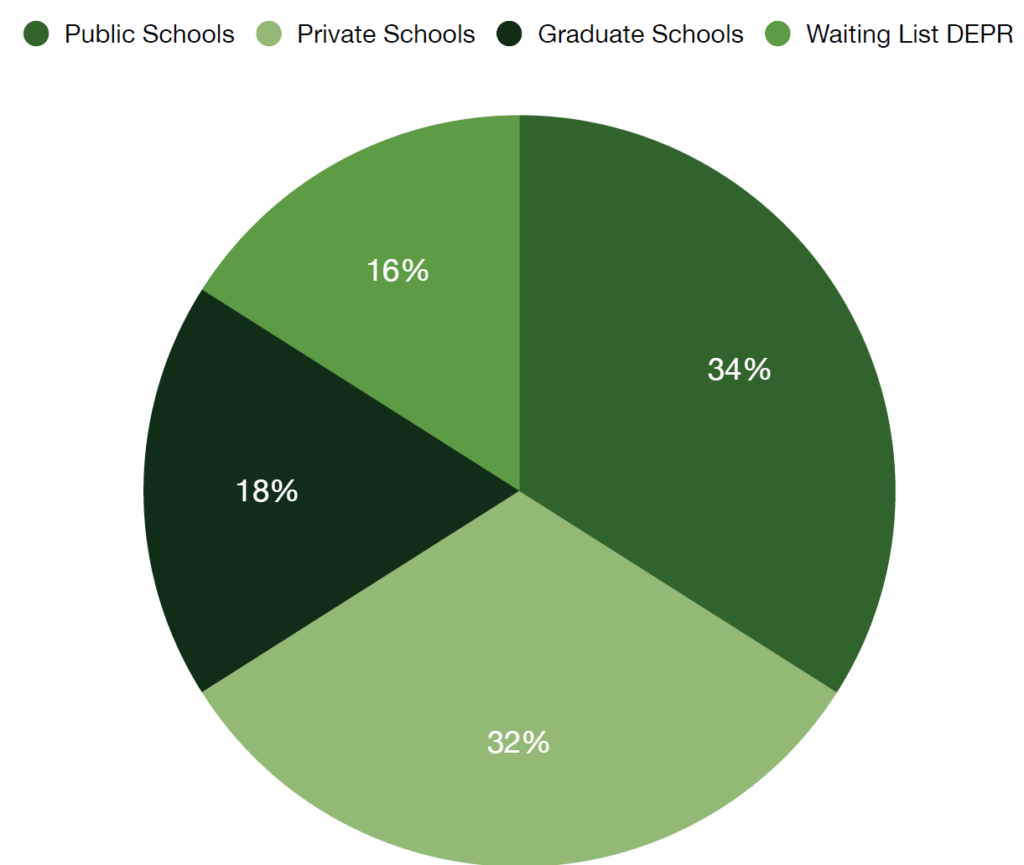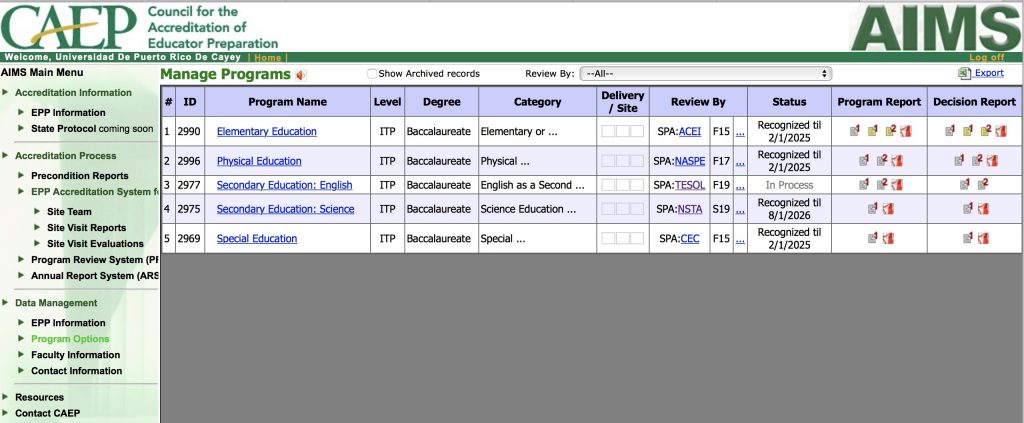
HIGHLIGHTS
Program and Enrollment: Interests are trending higher for Initial Certification programs because of the excellence of the EPP and the need of teachers in our island.
Licensure and Employment Statistics: Program completers demonstrated the ability to achieve licensure in Puerto Rico when they applied for it. Completers, when employment was shared, demonstrated their commitment and the ability to persist in the teaching profession.
Pre-Service Performance Data: Candidates have been rated well above the minimum point of meeting standard on the student teaching rubric, and their performances approximate those of the State or national average for the PCMAS licensure exams.
Stakeholder Satisfaction: Employers expressed satisfaction with program completers’ performance at higher rates than completers rated satisfaction with their own performance. Completers expressed very strong overall satisfaction with their preparation at UPR Cayey—90-100% satisfaction!
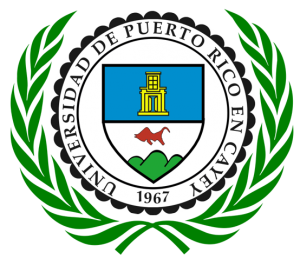
PROGRAMS AND NATIONAL RECOGNITIONS/ACCREDITATIONS
Gr 4-6: Elementary Education, B.S., Initial Certification; Nationally Recognized by ACEI
Gr K-12: Special Education, B.S., Initial Certification; Nationally Recognized by CEC
Gr K-12: Physical Education, B.S., Initial Certification; Nationally Recognized by NASPE
Gr 7-12: Secondary Education: Science, B.S., Initial Certification; Nationally Recognized by NSTA
ENROLLMENT STATISTICS AND TRENDS
Enrollment information is derived from the SAER UPR data. Enrolled candidates are those who have been formally admitted to the UPR Cayey and to the EPP (Education Preparation Program). The enrollment trend showed a decline in total numbers in part because the emigration to United States after the Hurricane Maria, the earthquakes that affect Puerto Rico in the past years and the COVID Pandemic. By program, interest continues to be highest in Secondary Science Education and Physical Education. Enrollment patterns demonstrate a slight downward trend overall for Spanish Education, but enrollment has held steady for Special Education.
PROGRAM RETENTION AND COMPLETION STATISTICS AND TRENDS
Retention and graduation information is derived from the SAER UPR data. Over the last 11 years, the programs have graduated approximately 64 completers per year who are eligible for teacher certification primarily in Science, Special Education and Physical Education. Graduation rates have held steadily. In 2021-2022 we have 42 Completers.
CAEP ACCOUNTABILITY MEASURES
MEASURE 1: Completer Impact and Effectiveness (Initial Certification)
MEASURE 2: Satisfaction of Employers (Initial Certification)
Puerto Rico Education Department does not release measures of P-12 student learning/development to teacher preparation programs nor on indicators of teaching effectiveness. The Education Preparation Program (EPP) has developed a means of tracking impact on P-12 student learning/development and on teaching effectiveness through the use of multiple correlated instruments: (1) alumni report survey seeking completer reporting of teacher evaluation ratings, percentage of students achieving targets, and self-perception of application of professional knowledge, skills, and dispositions; (2) employer survey seeking reporting of alumni teacher evaluation ratings, percentage of alumni students achieving targets, and observed alumni application of professional knowledge, skills, and dispositions.
Completer Impact on P-12 Student Learning/Development & Application of Knowledge, Skills, and Dispositions in the P-12 Classroom
The 2021-2022 ratings reported by employers of recent initial certification candidates (n=7) regarding impact on student learning and on progress toward retention/tenure were well within the “very satisfied» range, and were just about as high when alumni (n=20) reported on their own self- satisfaction in these categories. Application of knowledge, skills, and dispositions is also well within the «satisfied» range for each of the four InTASC categories, as indicated by employer satisfaction and by alumni self-satisfaction.
MEASURE 2: Satisfaction of Employers and Stakeholder Involvement
Data gathered in 2021-2022 from employers of recent initial certification alumni has been aggregated due to small sample size (n=7). Employer responses for these years indicated a strong sense of satisfaction with program completer performance in the classroom in all categories, including impact on P-12 student learning and all four major aspects of the knowledge, skills, and dispositions required of teachers. Employers’ perception of candidates’ professional preparedness, licensure area, and their degree conferral from UPR-Cayey were the top three contributors to employers’ decisions to hire.
Similarly, data gathered in the same period from initial certification program completers (n=20) also indicated a sense of satisfaction with the preparation received at UPR-Cayey 90-100% satisfaction per area. Alumni overall satisfaction with the teacher preparation programs had greatest representation in the Very Satisfied rating (76%).
Stakeholder Involvement (2022)
Program faculty met with the Dean 1/22 to address updated guidelines related to in person clinical experiences. These included candidate responsibility to abide by protocols in place at respective placement schools, the requirement for candidates enrolled in clinical experiences and student teaching to submit a comprehensive log of activities for all experiences both to ensure compliance with hours and to enable EPP personnel to assess depth and breadth of actual student/classroom experiences. These also included guidelines for approved field experiences and supervision of clinical experiences, such as holding all field experiences. Partnering principals, cooperating teachers, current students, alumni, and program faculty met with the UPR CAEP team for an accreditation updates.
MEASURE 3: Candidate Competency at Program Completion (Initial)
Candidates complete a number of formative and summative assessments over the course of a preparation program. Summative assessments include program completer data from a student teaching performance assessment called the Student Teaching Rubric (STR), the Teacher Work Sample (TWS), the Teaching Unit (TU) and the Community Service Project (CS) and the State licensure exam called the Prueba para la Certificación de Maestros (PCMAS) that varies by program. Results for each have been aggregated (n=42)
Ability of Completers to Meet State Requirements for Certification (2022)
Data for initial Puerto Rico certification has been gathered from the information receive PCMAS licensure test. A 98% of program completers achieved PCMAS certification of Puerto Rico in all specialities. Data for licensure test pass rates has been informed by College Board. The PCMAS individual exam pass rates were 100% for program completers in 2019 to 2021, and the tests’ average scaled scores above the Puerto Rico averages for the same time period in all the specialities.
MEASURE 4: Ability of Completers to be Hired in Education Positions for Which They Have Been Prepared (Initial)
Data for these statistics has been compiled from alumni self-reporting. Just over 54% of the graduating reported their employment: 66% of initial certification graduates employment was known were teaching in accordance with their preparation, 18% of the of initial certification graduates are in Graduate School and an additional 16% in the waiting list of Puerto Rico Department of Education. UPR-Cayey initial cert program completers demonstrated their consistent commitment to teaching students in a variety of settings, particularly in our Island, 34% of completers began teaching in the public schools and 32% in charter or private schools.
Employment Status First Year After Graduation (2022)
The Council for the Accreditation of Education Preparation (CAEP) is poised to raise the bar for preparation of educators in our nation. CAEP will serve as a model accreditor with rigorous standards, demanding sound evidence and establishing a platform to drive continuous improvement and innovation. As its first initiative to achieve those goals, the CAEP Board of Directors created the CAEP Commission on Standards and Performance Reporting and charged it with transforming the preparation of teachers by creating a rigorous system of accreditation that demands excellence and produces educators who raise student achievement.
Student Surveys
Acreditación CAEP a Pedagogía UPR Cayey
Diversity Tracking System (2022)
Report Card Survey 2022 (clave de matriculación-caep)
Intasc Model Core Teaching Standards 2011
- Grados Otorgados (2011 – 2022)
- Graduation Rates (2012 – 2022)
- Annual Retention of First-Time Degree Seeking Freshmen 2001 to 2022
- Matrícula (2011-2012-2019-2020)
- Distribución de Matrícula Total de Estudiantes por sexo y Departamento (2011-2023)
- Distribución Matrícula Total de los Estudiantes por Sexo y Departamento 2011 al 2022
- Distribución de Matrícula Total por Año de estudio, Departamento y Sexo 2021- 2022
- Tendencias Tasa Aprobacion PCMAS (2004-2019)
- Institutional Profile UPR-Cayey 2021-2022

